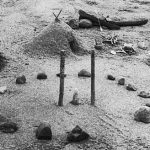 Weird Stuff
Weird Stuff  Weird Stuff
Weird Stuff  Mysteries
Mysteries 10 Tragic Disappearances and Deaths in Joshua Tree National Park
 History
History 10 Ways Childhood Really Sucked in the Old West
 Music
Music 10 Name Origins of Famous Bands from the 1990s
 Religion
Religion 10 Biggest Turnarounds by the Catholic Church
 Weird Stuff
Weird Stuff 10 Unbelievable Times Laws Had Unintended Consequences
 Humans
Humans Ten Historic Women Who Deserve Way More Credit Than They Got
 Movies and TV
Movies and TV 10 Films That Spawned Major Lawsuits
 History
History Ten Times Towns Were Wiped Off the Face of the Earth
 Creepy
Creepy 10 of the Most Disturbingly Haunted Public Houses in the UK
 Weird Stuff
Weird Stuff 10 Niche Subcultures That Are More Popular Than You Might Think
 Mysteries
Mysteries 10 Tragic Disappearances and Deaths in Joshua Tree National Park
 History
History 10 Ways Childhood Really Sucked in the Old West
Who's Behind Listverse?

Jamie Frater
Head Editor
Jamie founded Listverse due to an insatiable desire to share fascinating, obscure, and bizarre facts. He has been a guest speaker on numerous national radio and television stations and is a five time published author.
More About Us Music
Music 10 Name Origins of Famous Bands from the 1990s
 Religion
Religion 10 Biggest Turnarounds by the Catholic Church
 Weird Stuff
Weird Stuff 10 Unbelievable Times Laws Had Unintended Consequences
 Humans
Humans Ten Historic Women Who Deserve Way More Credit Than They Got
 Movies and TV
Movies and TV 10 Films That Spawned Major Lawsuits
 History
History Ten Times Towns Were Wiped Off the Face of the Earth
 Creepy
Creepy 10 of the Most Disturbingly Haunted Public Houses in the UK
Ten Long-Gone Ancient European Cities
Lost cities have always captivated our imagination. From Atlantis to El Dorado and the Lost City of Z, we’ve always wondered how ancient civilizations really lived. Sure, some have been rediscovered, like Troy, Petra, Memphis, and Machu Picchu. But others remain shrouded in mystery. These lost cities aren’t limited to faraway lands, either. Europe has more than its own fair share of missing metropolises as well!
So let’s explore ten long-lost ancient European cities. Although these places have vanished, historians hope to uncover their secrets one day. Some have been stumbled upon in small ways by chance in recent times. Others remain elusive and completely out of the public eye. A few more yet have even entered the realm of myth and legend. But we won’t stop wondering what became of these bustling urban centers. And maybe one day, we’ll know!
Related: Top 10 Amazingly Preserved Ancient Foods
10 Evonium, Scotland

Evonium is an ancient place steeped in Scottish history. And like all the rest on this list, it is shrouded in myth and legend. Its origins trace back to the ancient Scottish kings of centuries past. Hector Boece, a Scottish historian, first mentioned it in the 16th century. However, skepticism surrounds Boece’s accounts and the list of kings dating back to 330 BC. Many of them are intertwined with folklore and should be taken with caution. Despite this, the genealogy of these semi-mythical monarchs was established by the 13th century. So there is something there—even if it’s hard to parse.
As for the lost city itself, the actual location of Evonium is a subject of debate. Many believe it to be at Dunstaffnage near Oban in western Scotland. Other Scottish historians suggest that if Evonium did exist, it would likely be found in Irvine, further south. Irvine held greater strategic significance as an administrative and military hub during the Middle Ages, unlike Dunstaffnage, which was secluded. Plus, Irvine’s surrounding lands were historically known as Cunninghame, meaning “king’s home,” at the time. That area’s association with numerous ancient Scottish rulers makes it a likely spot for Evonium to have been.
Given the scarcity of reliable evidence, Evonium can be viewed as Scotland’s equivalent of England’s Camelot. It is a legendary and romanticized seat of power rather than a confirmed historical site. But that hasn’t stopped people from wondering what might have been. And where it might have been![1]
9 Tartessos, Spain
Tartessos was a very prosperous city in ancient times. It originally gained fame for its immense wealth and was often compared to the legendary El Dorado. Situated in present-day Andalusia, Spain, Tartessos was both a region and a bustling harbor city. Its culture blended influences from Phoenician and Paleohispanic people. Economically, it leveraged abundant metal deposits like copper, tin, lead, silver, and gold.
The city’s prosperity became so renowned that it was even mentioned in the Bible. In the Old Testament’s Book of Kings 10:22, it is stated, “the navy of Tarshish [Tartessos]… brought gold, and silver, ivory, and apes, and peacocks” every few years. Due to the scarcity of historical sources and the semi-legendary nature of Tartessos, scholars initially considered it a myth. Some even speculated it might be the fabled Atlantis, as described by Herodotus. Considering its location beyond the Pillars of Hercules, now known as the Strait of Gibraltar, that was a common assumption.
But the city really did exist—it’s just completely gone now. Adding to the intrigue, Tartessos is believed to have sunk in the marshes of the Guadalquivir River southwest of Seville. That waterway once served as a navigable estuary connecting inland communities to the Atlantic. Whatever the case was with Tartessos then, we don’t know much about it now. Beyond myth, legend, and possible fact—and likely a mix of the three—the famed former city of silver and gold remains firmly planted in history.[2]
8 Castro, Italy
Castro was an ancient city set in modern-day Lazio, Italy. It was founded in prehistoric times and later inhabited by the Etruscans. It may possibly be their lost city of Statonia, in fact. In 1537, Pope Paul III established the Dutchy of Castro there. Sensing the region as important, he named it the capital and appointed his son, Pier Luigi Farnese, as its duke.
For over a century, the Farnese Family ruled both the duchy and the city. But slowly, tensions arose with Pope Innocent X due to past grievances. The pope accused Ranuccio II Farnese of assassinating the newly appointed bishop of Castro. Incensed at the assassination, the religious leader led the Papal armies into battle. In August of 1649, the duke was defeated. Then, on September 2nd of the same year, the pope ordered the complete destruction of the city in response.
As a final act of revenge, the Pope erected a column amid the smoldering ruins. Chillingly, it bore the inscription “quì fu Castro.” Those who know Italian know where this is going: “Here stood Castro.” The city is now an overgrown ruin within Lazio.
Ever since its destruction, it has remained abandoned as nature grows up around it. Castro’s ruins are still, to this day, a haunting reminder of its former existence. They make for a picturesque view of the surrounding countryside—but a dark warning of what happens when one crosses someone as powerful as the pope.[3]
7 Rungholt, Germany
The city of Rungholt in northern Germany has been termed by many historians as the “Northern Atlantis” of ancient Europe. Once thought to be a myth, we now know it was real—even if we don’t know much else. Although its exact whereabouts remain uncertain, this bustling trading hub succumbed to the depths of the Wadden Sea in the latter half of the 14th century AD. Severe storms during this period caused the conversion of fertile marshes into tidal flats. That led to the demise of the entire medieval Uthland region, which housed Rungholt and other smaller towns.
In January 1362, a devastating tempest known as the 2nd of St. Marcellus’ floods unleashed its fury. It destroyed over 30 settlements and claimed the lives of approximately 10,000 people in and around Rungholt. Across the North Sea coast, Britain, and Ireland, the storm’s wrath reached a staggering toll of about 25,000 lives.
Moreover, it dramatically reshaped the coastline. It pushed the sands miles away from their former position. That, in turn, permanently changed agriculture and commerce in the area. Within the region, Rungholt had reigned as the largest settlement and a vital trade hub connecting Scandinavia, Northern Germany, Flanders, and England. But the weather proved too much for it to sustain itself in the decades after.
Historical estimates suggest that, at the time of the storm’s onslaught, Rungholt was home to around 2,000 people. That was equivalent to one-third of Hamburg’s population at that time. But just a few years after the storm surge, those who hadn’t been killed had long since left. The natural alterations to the area proved too much to push the city into a new era.[4]
6 Noreia, Austria
Deep in the eastern slopes of the Alps supposedly lies Noreia. It is said to be an ancient city that once served as the capital of the Celtic Kingdom of Noricum. This kingdom, ruled by the Taurisci tribe, encompassed modern-day central Austria, parts of southern Bavaria, and northern Slovenia. The Celts discovered the region’s rich iron ore deposits around 500 BC. Quickly, that led to the establishment of a thriving steel industry.
Around 200 BC, Noricum forged a strong alliance with the Roman Republic. In exchange for military support, the Norici provided the Romans with exceptional weaponry and tools. This partnership proved crucial when the Cimbri and Teutones, two powerful Germanic tribes, invaded Noricum’s lands. Despite suffering a crushing defeat in the Battle of Noreia in 112 BC, the Romans ultimately emerged victorious in the subsequent Cimbric War.
But then the trail of Noreia and its people goes cold. The precise location of both the battle and Noreia itself remains a subject of ongoing debate. Pliny the Elder, a prominent figure of the 1st century AD, already considered Noreia a lost city during his lifetime. So it’s only gotten even more lost from there.
Further complicating matters, Noriea also referred to the national goddess of Noricum. Thus, historians believe the name may have been applied to multiple places as a show of adoration. Knowing that, experts may be spinning their wheels looking for multiple lost cities, never to find the “right” one.[5]
5 Vicina, Romania

Vicina was once a thriving trade hub in what is now southeastern Romania. It was strategically situated on the Lower Danube and important for its time. Its prime location allowed it to flourish—and also contributed to its downfall. Built by the Genovese in the 10th century, Vicina enjoyed its peak in the 13th century. But it experienced a major decline in the mid-14th century. Without warning, it then vanished from records by the late 15th century.
The Danube Delta served as a meeting point for the Byzantine Empire, the Golden Horde, and the West. Vicina was well-positioned on the major, easily-navigable river. Thus, it strategically facilitated trade among these powers. The Mongol conquest of the center during the 13th century ushered in a period of relative peace known as the Pax Mongolica. That, too, further supported commerce. Over the centuries, it changed rulers several times. The Genovese, Mongols, Pechenegs, Turks, Byzantines, and Tatars all controlled it. But trade in Vicina remained uninterrupted and mutually beneficial.
However, the decline of Vicina began after the Genovese-Byzantine War of 1351-1352. After that war, the Byzantines lost all control of the Lower Danube. The resulting power vacuum and increased instability in the region caused a reconfiguration of trade routes. New markets favored the port in Braila on the more peaceful Wallachian side of the river. Slowly, and then all at once, the town died out.
Some scholars also speculate Vicina’s disappearance was due to a natural phenomenon. Based on maps and descriptions from that era, they believe the once mighty trading center was situated on an island that eventually sank beneath the river. Between those two issues, Vicina wasn’t destined to live out its days forever. Its powerful time in the sun came and went, and it’s now forever a thing of the past.[6]
4 Seuthopolis, Bulgaria
Seuthopolis was the capital of the Odrysian Kingdom when it was established in the late 4th century BC by King Seuthes III. It emerged after the Persians retreated from Europe following their failed invasion of Greece in 479 BC. That left a power vacuum, and King Seuthes took the opportunity for himself.
Soon, the Odrysian Kingdom, a Thracian kingdom and ally of Athens, became the dominant outfit in the Balkans. It ended up covering present-day Bulgaria, Northern Greece, Southeastern Romania, and European Turkey. Previously, the kingdom lacked a fixed capital. But Seuthopolis served that need after a while.
Lost for centuries after the kingdom’s downfall, Seuthopolis remained hidden long since. That is, until its discovery in 1948 during the construction of the Koprinka Reservoir in central Bulgaria’s Rose Valley. It was underwater—and very well preserved. Excavations revealed Seuthopolis as an elite Thracian settlement heavily influenced by Greek-Hellenistic culture. Although distinct from a true Greek city-state, it featured Greek-style buildings and houses. The city had two main intersecting roads forming an agora. It also had paved streets, underground drains, and a grid pattern creating rectangular blocks.
In contrast to typical Greek towns, the common people of Seuthopolis resided outside the city walls. The buildings were spacious and luxurious, with generous gaps between them. The king’s palace was separate from the rest of the town. It had been fortified by its own walls and watchtowers. To experts, that suggested a lack of “national unity” within the Odrysian Kingdom. The king likely acted more as an overlord to other tribal leaders. Notably, each house possessed its own altar, which was a practice common in the Middle and Late Bronze Ages. Additional evidence supports Seuthopolis as a religious center, with Seuthes potentially serving as a priest-king.
Beyond that, there’s not much we know about the city of Seuthopolis itself. There is likely much more to learn under that reservoir and many more artifacts to uncover. But just the existence of the city itself allows for fascinating insights into the ancient world. Consider the underwater excavation to be Bulgaria’s version of Atlantis![7]
3 Pavlopetri, Greece
On Greece’s Peloponnese Peninsula, marine geo-archaeologist Dr. Nicholas Flemming made an astounding discovery in 1967. He uncovered the remains of an ancient lost city called Pavlopetri. At the time, it had been considered the oldest underwater city in the Mediterranean. And undoubtedly, it was one of the world’s oldest. But even after his discovery, there still remains much we don’t know about the urban center.
Originally believed to belong to the Mycenaean period (1600-1100 BC), further research revealed it was inhabited as early as 3500 BC. That would make it active during the Final Neolithic era. Archaeological studies indicate Pavlopetri was a thriving trade hub with a significant textile industry. And because it was out on a peninsula in a relatively rural area, the city’s structure remains intact. It has been untouched by agriculture or subsequent construction. That random spot of good luck has helped archaeologists quite a bit.
Over the centuries, a series of earthquakes gradually submerged the ancient Greek settlement. When initially established, Pavlopetri stood a few feet above sea level. By 1200 BC, it had receded to roughly three feet above the shoreline. And that simply wasn’t enough.
Eventually, due to ongoing tectonic activity, the city sank approximately 13 feet (4 meters) below sea level around AD 480 to 650. Now, between being isolated and underwater, it remains relatively well preserved. In that way, it offers us in the modern era a fascinating glimpse into what life used to be like.[8]
2 Jomsborg, Poland
Way back when, the city of Jomsborg was a fortified settlement of a group of people known as the Jomsvikings. It likely existed between AD 960 and 1043 on the southern Baltic Sea coast. It was most likely in Poland, though some experts claim northeastern Germany. The Jomsvikings were Viking warriors who fought as mercenaries for other groups. Their communities held a strict code of conduct too. To join, they had to defeat a member in combat. Once inside the walls of the fortified city, residents had to abide by rules like no quarreling and no showing fear.
The exact location of Jomsborg remains uncertain, of course. Some go so far as to doubt its existence, viewing it as a Viking legend. But the Icelandic sagas, particularly The Saga of the Jomsvikings, provide the most information about the fortress. So it’s clear there really was something there—wherever that may be.
The Jomsvikings declined after significant defeats and were ultimately destroyed in 1043 by Magnus Olafsson, the King of Norway. From that point, their existence fades into history. Now, archaeologists are desperate to find where their city might have been. But so far, nobody has had any luck in figuring it out.
One suggested location for Jomsborg is the present-day town of Wolin in northwestern Poland. However, archaeological evidence doesn’t fully support this theory. Another possible location is Usedom Island, adjacent to Wolin on the German side of the Oder River, now submerged land. For now, it’ll all remain a question until hard evidence can turn up.[9]
1 The Ring, Hungary
After Attila the Hun’s death and the downfall of the Hunnic Empire in AD 469, Europe enjoyed a temporary respite. However, this peace was short-lived. Soon enough, the Avars emerged to fill the power vacuum. They were a group of aggressive nomads from the Mongolian Steppes, and they meant business.
Under King Bayan I, the Avars triumphed over the Gepids in AD 567. Then, they settled in the Pannonian Plain across south-central Europe. Curiously, the Gepids were the same people who had ousted the Huns a century earlier. Legend has it Bayan even killed the Gepid king Cunimund and turned his skull into a macabre drinking vessel as an act of revenge. Anyways, the Avars were soon oppressing the locals, conscripting them as expendable soldiers for their future wars.
The Avars also built one major metropolis in the area too. They quickly constructed and fortified their massive new headquarters known as The Ring. It was placed near Attila’s former capital and became a bustling urban center of its own. Its name was likely derived from its circular shape, but little is known about it. Throughout the following centuries, the Avars conducted numerous raids around the region using The Ring as a home base. They attacked the Byzantines in the Balkans and even laid siege to Constantinople.
After a long run, their downfall came at the hands of Charlemagne, the Frankish ruler who ascended to power in 768. Charlemagne led successful campaigns that plunged the Avars into a devastating civil war by 794. The following year, he effortlessly seized The Ring. It contained centuries’ worth of plundered riches—and he plundered right back. Legend has it that fifteen wagons, each pulled by four oxen, were required to transport this vast hoard back to Paris. Today, the exact location of The Ring remains unknown. Even so, historians think it may lie somewhere in Hungary between the Danube and Tisza Rivers.[10]








